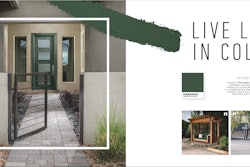 Photo: Pixabay
Photo: PixabayWhen you’re first starting out in the lawn care business, you might think grass is grass, but there’s much more to it than that. If your customer is looking for the quintessential green lawn, you need to know what kind of grass is best suited for your client’s region.
Generally speaking, grass types fall into two broad categories that are fairly intuitive: warm-season and cool-season.
Once you determine which of those groups your service region falls in, it’s a matter of choosing a grass type that’s well-suited for your area. Below are just some of the warm-season and cool-season grasses to be aware of.
Warm-season grass types
Warm-season grasses are referred to as southern grasses because they thrive in hot climates. These drought-tolerant grasses can grow in poor soil and tend to require minimal watering.
Warm-season grasses are known for being their greenest during summer and tend to go dormant during winter.
Bermuda grass
Bermuda grass is the premium choice for the southern half of the United States. This grass remains lush and green in hot summers despite times of drought, growing to a beautiful medium-to-dark green year-round in warmer climates.
While this dense grass thrives best in warm weather, Bermuda grass can tolerate cooler temperatures down to 60 degrees. That makes it an ideal choice for zones 7-10 of the USDA Plant Hardiness Zones.
Buffalo grass
For clients seeking a low-maintenance lawn, buffalo grass is a prime choice. Buffalo grass requires minimal irrigation and thrives in sunny weather, making it a terrific option for residents of the southern half of the United States.
While slow to grow, buffalo grass will go from brown in the winter to a lovely dark green in the peak of summer.
Buffalo grass can take up to two years to establish, but once it does your client will have a tough turf that serves as an excellent home lawn. For optimum growth, plant buffalo grass in zones 5-7.
Zoysia grass
If your customer’s lawn needs to withstand heavy foot traffic, zoysia grass may be the grass type for them. Zoysia can withstand high foot traffic and grows best in the southern states, specifically zones 7-10.
Once established, zoysia takes on a sports turf-like texture with deep roots. These deep roots make it easier for damaged grass to bounce back.
Drought tolerant and weed resistant, zoysia can grow in full sun to partial shade with minimal watering.
Bahiagrass
Bahiagrass is a unique grass seed that, when treated right, leaves residents with a gorgeous light-green, low-maintenance lawn.
Bahiagrass is fairly easy to grow in USDA zones 7-11, as long as you don’t plant this grass in acidic soil or shady areas.
Bahiagrass doesn’t fare well in areas with high traffic, so keep that in mind. However, it does establish well in poor soil and regions with little rain. The coarse grass blades have been known to grow rather tall, so frequent mowing is required.
Cool-season grass types
Cool-season grass types grow best in cooler climates during the fall and spring. While cool-season grass grows throughout the United States, the northern states present the most ideal growing conditions.
It’s best to plant cool-season grass in the spring or fall and watch how they flourish in the winter.
Kentucky bluegrass
Kentucky bluegrass grows best in the northern United States where temperatures are cold and humid. Considered to be a meadow-grass, Kentucky bluegrass is used for everything from landscaping to athletic fields.
With constant watering, Kentucky bluegrass’s thin blades will spread fast to produce a thick, matted lawn that’s ideal for play. Just be sure to water this grass frequently due to the shallow roots.
For the best results and happy clients, plant Kentucky bluegrass in zones 2-7 to ensure a green lawn.
Perennial ryegrass
If you’re looking for a fast-growing, versatile grass seed, then perennial ryegrass is right up your alley. Perennial ryegrass grows throughout the United States where it establishes fast.
In the northern states, perennial ryegrass serves as an excellent cool-season choice.
Meanwhile, in the southern states, this grass is often used during the winter to overseed other warm-season grasses. This can allow your customers to have a green lawn all year long.
From homes to sidewalks and athletic fields, plant perennial ryegrass anywhere you expect high foot traffic.
Fine fescue
From Washington to Maine, fine fescue is a favorite grass type for residences and businesses alike. This grass is coveted for being disease-resistant, fast-growing, and highly tolerant to the cold.
Plant fine fescue in cold climates and watch it thrive despite poor soil conditions or shade. Just be sure to spread out the seeds evenly as this grass type is known to bunch.
Growing best in planting zones 2-7, fine fescue serves all your lawn needs from cover crop to golf courses.
EDITOR’S NOTE: This article was written by Jana Gray, a professional copywriter, freelance writer, and avid outdoor enthusiast from Seattle, Washington.










